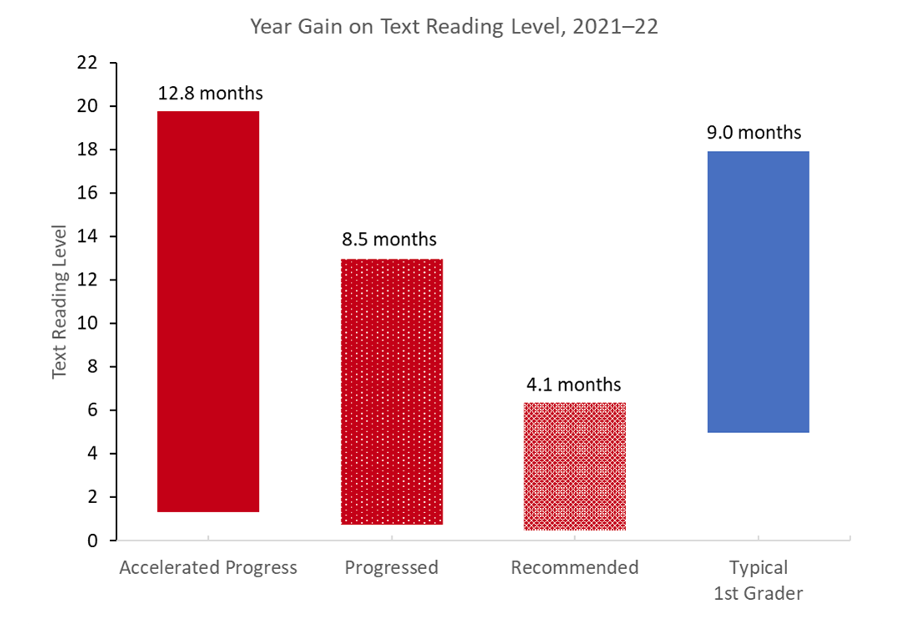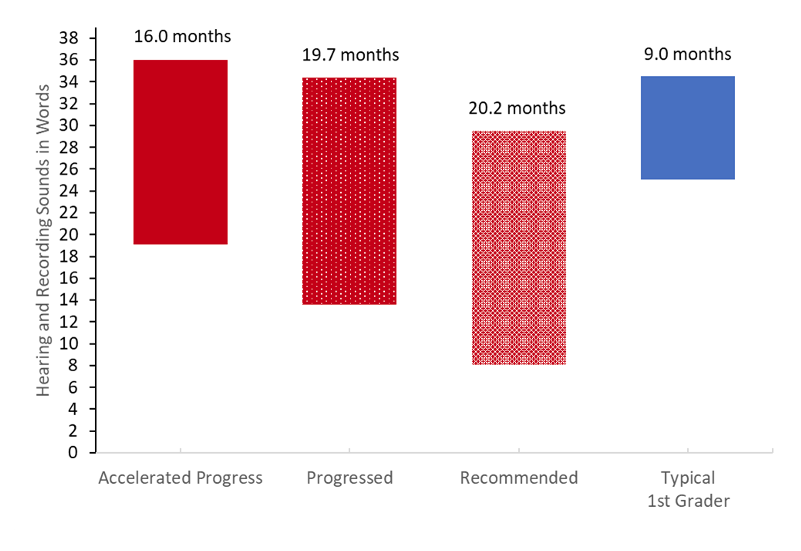BLOG
Data Dives with IDEC: Delving Deeper into Student Growth
By Dr. Kate Nelson and Dr. Susie Mauck
In our last post, we explored student growth with Observation Survey (OS) Total Scores for students with an outcome status of Accelerated Progress and Progressed. In this post, we’ll dig deeper into student growth by examining the change in OS Total Scores over time and their growth on two of the OS tasks in 2021–22.
When examining data, we want to both zoom out and zoom in. Zooming out, Figure 1 shows the change in average growth in OS Total Scores for students in the two years prior to the pandemic and the two years after the start of the pandemic. Overall, scores for children with an outcome status of Accelerated Progress remained steady, achieving year-end scores of about 550, on average, despite starting the school year with lower average scores since the pandemic. In 2020–21 and 2021–22, children with a status of Accelerated Progress started the year with average OS Total Scores that were 40 points lower than those of typical first graders but finished the year with higher average OS total scores. Children with an outcome status of Progressed made similar growth, averaging just under 13 months growth for the two years combined. On average, they began the year with OS Total Scores that were 65 points lower than the typical first grader and finished the year just 17 points lower than the typical first grader. Since the pandemic, children with an outcome status of Recommended started the year with OS Total Scores that were 89 points lower on average than the typical first grader. Their average growth rate was just over 10 months, and they ended the year with average scores that were 72 points lower than the typical first grader.
Figure 1

Next, we’ll zoom in, narrowing our focus to the Hearing Sounds in Words task and the Text Reading Level task on the Observation Survey for 2021–22. In Figure 2, we see the average months growth in Text Reading Level scores for students with outcome statuses of Accelerated Progress, Progressed, and Recommended compared to the typical first grader. Overall, all Reading Recovery children began the year at similar text levels, but children with an outcome status of Accelerated Progress made the strongest gains. Children with an outcome status of Accelerated Progress averaged 12.8 months growth. Their average text reading level in the fall was 1.3 and they ended the year just below level 20. Compared to typical first graders, on average, these students started the year almost four text reading levels lower and ended the year with text reading levels that were almost two levels higher. Children with an outcome status of Progressed averaged 8.5 months growth, starting the year with an average below level one (i.e., 0.8,) and ending the year with an average text reading level just above 12 (i.e., 12.2). Children with an outcome status of Recommended started the year with an average text level of 0.5 and ended the year at level 5.9, averaging 4.1 months growth.
Figure 2

Figure 3
In Figure 3, we examine the average growth on the Hearing and Recording Sounds and Words task for children with an outcome status of Accelerated Progress, Progressed, and Recommended, compared to the typical first grader. Overall, children with an outcome status of Recommended had the most growth, averaging 20.2 months, followed closely by children with an outcome status of Progressed, averaging 19.7 months growth. Children with an outcome status of Accelerated Progress averaged 16.0 months growth, ending the year with an average score of 36.0 (out of 37). Meanwhile, children with an outcome status of Progressed ended the year with an average score of 34.4, almost reaching the average of the typical first grader, and children with an outcome status of Recommended made almost two years’ growth, ending the year with an average score of 29.5. The typical first grader started the year with a score of 25.0 and ended with a score of 34.5. This indicates that all three groups of Reading Recovery students made great progress, especially compared to the typical first grader.

Children in Reading Recovery made significant growth that resulted from their reading intervention. Looking at Figure 1, we see that growth for children with outcome statuses of Accelerated Progress and Progressed averaged 13 months or more, and children with Accelerated Progress maintained a year-end OS Total Score of about 550. Drilling down on two of the OS tasks, we see that children with an outcome status of Accelerated Progress made great progress in the Text Reading Level task, beginning the year below the typical first grader yet surpassing them by the end of the year, on average. For the Hearing and Recording Sounds and Words task, Reading Recovery children in all three categories made significantly more growth than the typical first grader, with Recommended and Progressed students averaging approximately 20 months growth. This task requires an important subset of literacy skills pertaining to letter-sound associations while the Text Reading Level task requires children to orchestrate all their literacy skills simultaneously to process text. This could explain why stronger growth is seen across all three groups in the Hearing and Recording Sounds and Words task while stronger growth is seen in just the Accelerated Progress group for the Text Reading Level task. Across all three sets of data, we see that children in Reading Recovery made significant growth in their literacy skills.

Kate Nelson is the IDEC International Data Evaluation Center Manager at The Ohio State University. She has a background in literacy, research, and teaching, and earned her Ph.D. in literacy education from The Ohio State University. At OSU, she received training in Reading Recovery and supervised children with reading difficulties in the university reading clinic. She worked with Dr. Lea McGee and colleagues to investigate first graders’ strategic use of information over time, resulting in a Reading Research Quarterly publication, as well as the International Literacy Association’s Dina Feitelson Research Award. She has experience in data analysis and research, as well as working with teachers in professional development and students in K-12 and higher education.

Susie Mauck was a public elementary school teacher before completing her doctorate at OSU in the College of Education and Human Ecology (EHE), Quantitative Research, Evaluation, and Measurement program. She specializes in quantitative methodology and has been supporting the work of the faculty and students in EHE since 2015.
THE JOURNAL OF READING RECOVERY
Spring 2025
OPEN ACCESS: Centering Children and Working Towards Equity: Teaching All Children to Read by Catherine Compton-Lilly
Literacy Leadership in Support of Equity: Whatever It Takes by Allison Briceño
Exploring the Purposes, Power, and Potential of Familiar Reading by Jamie Lipp
Full Circle: From Student to Psychologist by Joyce Romano




